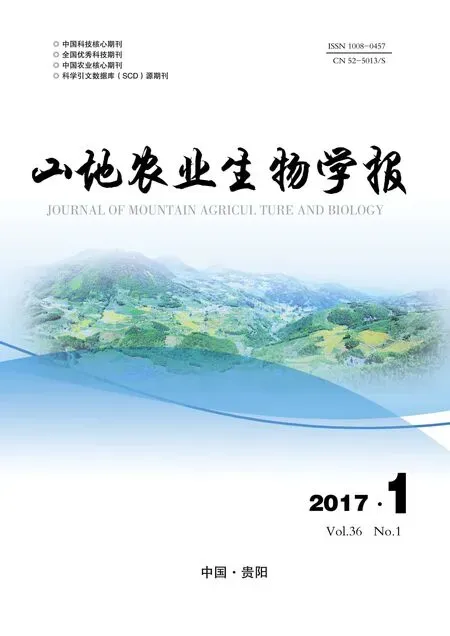A method to refresh dried larval specimens of Erythraeidae
XU Si-yuan, YI Tian-ci, JIN Dao-chao
(Institute of Entomology, Guizhou University, and The Provincial Key Laboratoryfor Plant Pest Management of Mountainous Region, Guiyang, Guizhou,550025,China)
A method to refresh dried larval specimens of Erythraeidae
XU Si-yuan, YI Tian-ci, JIN Dao-chao*
(InstituteofEntomology,GuizhouUniversity,andTheProvincialKeyLaboratoryforPlantPestManagementofMountainousRegion,Guiyang,Guizhou,550025,China)
The article reports a method of making dried larval specimens of Erythraeidae, ectoparasitism of insect, refreshed for taxonomic study. The dried larvae are let in cuvettes with 50% ethanol. The cuvette plat is then put into a beaker with water in appropriate amount, fulling to 1/3-2/3 high of the cuvette plat. The beaker is heated until the water boiling, and then stop to heat. After that, the treated larvae are immersed into a container with ethanol-glycerol solution (50% ethanol : glycerol = 20 : 1), and then the container is warmed in a Water-Bath at 60℃ for 2h to ‘refresh’ the larvae. The refreshed larvae are as mollescent as fresh ones and easy to be prepared for morphologic observation and long-term preservation.
Erythraeidae; larva; specimen preparing; insect
Introduction
The larvae of Erythraeidae are ectoparasitism of insect. Up to now, taxonomics of Erythraeidae is mostly based on the larvae. Generally, an acarologist preserves the larvae and host with 75% ethanol when collecting Erythraeidae in field. The preserved larval specimens are prepared with Oudeman’s fluid and observed under microscope, and the hosts are still preserved in the 75% ethanol[1]. While the entomologists and other insect collectors generally preserve the insect specimens with desiccant when collecting insects. In our study, we are usually looking for the mites in insect collections, and the mite larvae, which are valuable specimens for Erythraeidae taxonomic study, are often found in the container or the insect specimens, but they have dried and easy to be damaged. The dried larvae can not be prepared as microscope slides for taxonomic purpose without any treatment. In order to use the dried but valuable larval specimens, a workable and effective method to ‘refresh’ them is developed.
1 Materials and methods
1.1 Material
Regents: Glycerol, 50% ethanol, 60% ethanol, 70% ethanol, 80% ethanol, 90% ethanol, Oudeman’s fluid.
Equipment: eolipyle, Water Bath, beakers, cuvette plat, glass rod, centrifuge tube, volumetric cylinder.
1.2 Experiments to refresh the dried erythraeidlarvae
1.2.1 Selecting proper ethanol concentration Put 5 dried larvae into 5 cuvettes, each cuvette just for one larva. Add 5ml ethanol in different concentrations (50% ethanol, 60% ethanol, 70% ethanol, 80% ethanol, 90% ethanol) to every cuvette. Then put all cuvettes with larva and ethanol into a beaker; add an appropriate amount of water, filled to13/-2/3 high of the cuvette plat, into the beaker. Heat the beaker until water boiling for 3 min, then stand a while.
1.2.2 Selecting proper regent Put 3 dried larvae into 3 cuvettes, each cuvette just for one larva. Add 5 ml of the regent solutions (glycerol, 50% ethanol, Oudeman’s fluid) to every cuvette, one solution for one cuvette. Put all cuvettes with larva and different solution into a beaker. Then heating treatment follows

Fig.1 The equipment used in experiment refreshing the dried mite larvae
1.2.3 Refreshing treatment Refer to the ingredient and ratio of Oudeman’s fluid[1, 2], the ethanol-glycerol solution (50% ethanol : glycerol = 20 : 1) was used as solution to refresh erythraeid larva.
The ethanol-glycerol solution was made as follows: Add the regents (50% ethanol : glycerol = 20 : 1) into a beaker, then, heat the beaker, stirring with eolipyle, and stop heating when glycerol completely dissolved in ethanol.
Put the treated larvae in 1.2.1 and 1.2.2 into different centrifuge tubes separately. Add the mixed solution into these centrifuge tubes and seal them. Then put the tubes into 60℃Water Bath for 2h.
2 Results and analysis
2.1 Proper ethanol concentration for pretreatment
The treated larva with 70%, 80% and 90% ethanol severally were not refreshed as good as those treated with 50%or 60% ethanol. The pretreated dried larva with 50% ethanol could get higher moisture and were more conducive to the subsequent experiments. Therefore, 50% ethanol can be ideal concentration for pretreatment.
2.2 Proper regent solution for pretreatment
Comparing the treated larvae with glycerol, 50% ethanol, Oudeman’s fluid, the glycerol was better to protect the larval structure but the refreshing effect of the larvae was not as good as 50% ethanol and Oudeman’s fluid. The Oudeman’s fluid is better in refreshing effect of the larvae, but it damaged the larval structures. The pretreated larvae with 50% ethanol showed good refreshing effect and complete structure as normally preserved larva specimens.
3 Conclusion
Based on the results, the steps of refreshing the dried erythraeid mites with proper regent solutions are as follows:

The larvae of erythraeid mites are ectoparasitism of insect. They are usually to be damaged when separate them from the dried insect specimens and lose value for taxonomic study. The commonly used method for melting insect is not applicable for the dried larvae of erythraeid mites. The melting method proposed here can also be used to melt or ‘refresh’ adult mites, even other small arthropods.
[1] Krantz G W, Evans D, Walter D E. A manual of acarology[M]. 2009,87-91.
[2] LI longshu, LI yunrui. Acarology [M]. 1988,480-482.
2016-12-10;
2017-02-01
国家科技基础性工作专项重点项目(2014FY110100);国家自然科学基金(31272357);系统与应用蜱螨学创新团队([2014]33);贵州省节肢动物资源开发利用科技创新人才团队(20144001)。
Q95-34+4
A
1008-0457(2017)01-0079-03 国际
10.15958/j.cnki.sdnyswxb.2017.01.015
*通讯作者:金道超(1959-),男,教授, 博士生导师;主要研究方向:蜱螨学;Email:daochaojin@126.com。

